What is good about the Kassaba melon, how to choose and grow it
When we hear the word melon, we imagine a sweet, juice-filled fruit with a unique aroma. There are a great many varieties of melons, each of which has its own characteristics. Melon Kassaba is famous for the fact that the greatest sweetness and juiciness of its fruits are gained not for harvesting, but during storage, for winter.
Those wishing to get a harvest of this Far Eastern fruit in the country need to know the intricacies of growing a crop and its requirements for growing conditions.
The content of the article
Description of the variety
Turkey is considered the birthplace of the Kassab melon, and the golden beauty has appeared in Europe and the United States since the 1920s. It is easy to distinguish Kassaba from other types of melons by the nipple-like growth at the base of the peduncle and the wrinkled, almost warty, peel. The fruits reach full ripeness, juiciness and taste for winter, which allows you to enjoy the summer fruit for the New Year.
In the photo - Kassaba melon.
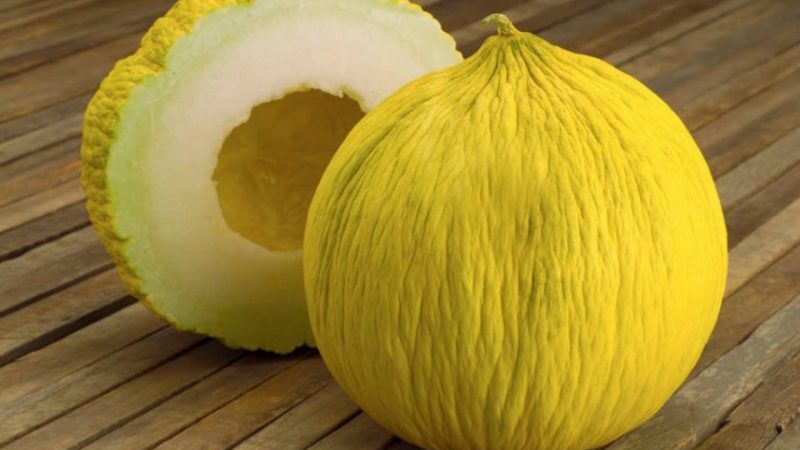
Composition, properties, calorie content
Melon Kassaba is a very nutritious and healthy fruit. Its pulp contains up to 12-18% of sugars, vitamins of group B, C, trace elements, organic acids, aromatic substances and enzymes. Thanks to enzymes, melon pulp easy to digest the body.
In addition, melon contains a large amount of folic acid, which is responsible for the growth of cells in our body, therefore, melons have an anti-sclerotic effect and promote resorption of tumors. With regular use fruit reduces the risk of heart attacks and strokes.
Melon seeds contain up to 23-35% fat, which makes it possible to obtain from them an oil that rivals olive in quality.
1 kg of Kassaba contains up to 300 kcal.
For reference. By the quantitative content of vitamin C, Cassaba melon is equated to spinach.
Specifications
The Kassaba melon is widely known in 2 varieties:
- Winter Kassaba. These are late-ripening varieties with a growing season of 75-100 days. They are harvested unripe and brought to ripeness in storage. The fruits of such melons are large and medium-sized, varied in shape, slightly flattened at the ends. The surface is golden, bright yellow or cream in color with large to medium-sized dark green spots. The pulp of ripe fruits is thick, dense, white, astringent in taste. Famous varieties: Valencia, Temporano, Honey Dew, Golden beauty. The latter are the most resistant to transportation and machine assembly.
- Summer cassaba combines melons of mid-season varieties with spherical fruits of greenish-yellow or orange color. The skin is absolutely smooth, without wrinkles. The pulp becomes sweet, tender and melting after short storage. Popular varieties: Zhukovsky, Honey dew.
Taste qualities
Freshly plucked winter Kassab tastes different from melon, but rather like a cucumber. After 2-3 months of storage, the fruits become sweet and juicy, acquire a barely perceptible aroma.
All summer cassabs have thick, fibrous, mouth-melting flesh with a high sugar content. Unlike winter melon, summer varieties are not stored and are used locally in growing regions on a "pluck and eat" basis.
Yield
The average weight of winter varieties is from 3 to 6 kg. The average yield when grown in greenhouses is 5-7 kg per sq. m. Outdoors - 2.5-4 kg per sq.m.
How to choose fruits when buying
When buying Kassaba, you need to pay attention to: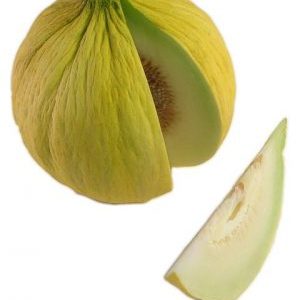
- Skin condition. It should be free from damage, signs of decay and mold.
- Density. After pressing with your finger, a dent appears on the surface of the melon, which disappears over time.
- Weight. A healthy fruit has a good weight as it is juicy and meaty.
- Distinctive features of the variety - the presence of a papillary growth at the base of the peduncle and rounded fruits.
- Ripeness. Unlike other melons, ripe Kassaba is chosen not for aroma, but for sound. Ripe melon, when struck with the palm, emits a dull clap.
How to grow a variety yourself
Sowing dates:
- In southern Russia, sowing in the ground in late April - early May.
- In central Russia, only summer early-ripening varieties of Kassaba are grown, for example, Honey Dew. Seedlings are sown in early May.
Seedling method:
- Seeds with a damaged shell, cracks and dots are discarded.
- Quality seeds are soaked in a dark pink solution of potassium permanganate for 30 minutes.
- For 1-2 days, the seeds are placed in wet gauze or sawdust and germinated until the root appears.
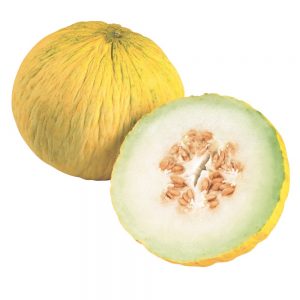
- Seedlings are sown directly into an individual container to a depth of 3-5 cm, since the melon does not like transplanting.
- The soil for planting should be breathable, moisture-absorbing, with neutral acidity in the range of pH 6.7-7.0. The composition of peat, sand and humus is considered ideal (ratio in buckets: 2: 1: 0.5).
- Seedlings are kept in a light window at a temperature of + 25 ° C.
- A week before planting, young plants are hardened by taking them to fresh air for 1-2 hours every day.
- Seedlings are planted in the phase of 5-7 true leaves, in early June. For normal survival of seedlings, the night temperature should not fall below + 15 ° C.
- Planting scheme: 80-90 cm between plants in a row, row spacing - 50 cm.
- Water the plantings with warm water.
- In sunny weather, planting for the first few days is covered with a thin non-woven material.
Direct sowing into soil:
- Seeds for sowing are prepared in the same way as when growing seedlings.
- Sprouted seeds are sown in a prepared bed in advance (from autumn) after May 20.
- If the soil does not fit the requirements of Kassaba, it is brought to the required acidity and air permeability: acidic soils are limed, baking powder (peat, sand) is added to heavy and clayey ones.
- The sowing pattern is traditional: the distance from seed to seed is 80-90 cm, in row spacings - 50 cm. Planting depth is 3-4 cm.
- Top with humus and watered abundantly.
Further care of young melon plants is as follows:
- Mulching the topsoil.
- Loosening and weeding.
- Regular feeding. The first is carried out 2 weeks after planting with mullein infusion solution. The second, phosphorus-potassium, is at the stage of bud formation. For the third time, Kassaba is fed with potassium fertilizer in the fruit setting phase.
- Watering is reduced to 2-3 times a week.
- In mid-July, non-pollinated flowers are removed, the number of ovaries is reduced so that the main fruits have time to ripen.
The large distance in the row between plants is not recommended by chance - the Kassaba melon is very light-requiring and prefers to grow freely.
Features of cultivation and possible difficulties
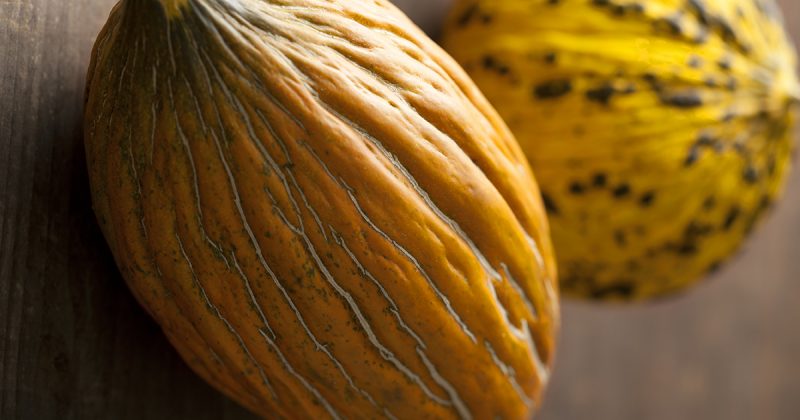
Regardless of the region of cultivation, Kassaba melon requires the formation of a bush into one stem. All side branches are removed. Long lashes are also not needed, as they will take food from future fetuses. They are removed over 4-5 sheets.
In the northern regions, when growing fruit in a greenhouse, regular ventilation is required. High humidity in the absence of ventilation causes many fungal diseases.
Melon reacts sharply to lack of mineral nutrition. How many times per season to feed a melon depends on the place of cultivation: on the southern chernozems, 2 additional dressings are enough (in the stage of active growth and the fruiting phase), and in the northern regions - 3-4 times per season.
Diseases and pests
Melon Kassaba is susceptible to fungal diseases:
- Powdery mildew appears as white spots on leaves and petioles.In the active phase of the disease, the leaves curl, turn brown and dry out.
- Downy mildew, or downy mildew, - the appearance of yellow-green spots on the leaves. If the disease progresses, the leaves become covered with a gray coating. Downy mildew, unlike true mildew, covers the underside of the leaf.
- Anthracnose, or copperhead. The leaves are covered with brown, rusty spots, become brittle and dry out. The fruits are affected in the same way.
- Fusarium... The disease is typical for late varieties. Appears in seedlings at the stage of 3 true leaves and at the time of fruit ripening. The leaves turn yellow, wither and become covered with a gray rusty coating.
- Root rot affects weak immature seedlings and weakened adult plants. It appears as a rusty spot at the base of the stem, which grows brown as it grows. Cotyledons and leaves dry up. Plants die.
If any fungal disease is detected, it is recommended to use a broad-spectrum fungicide: Topaz, Karbendazim, Ordan. For prophylaxis, the drug "Fitosporin" is added to the soil for sowing. Good dynamics is shown by the treatment with copper-containing preparations: Bordeaux liquid, "Oxyhom".
Important! For 3 weeks before harvest, no processing of any agrochemicals should be carried out.
The main pests of melon:
- spider mite (destroyed by Fitoverm, Bi-58);
- wireworm (insecticides "Bazudin" and "Zemlin" will relieve him);
- melon aphid (treatment with a solution of green soap or Actellik helps);
- melon fly (the drug "Kemifos" is effective).
Against pests, Kassaba melon has to be processed repeatedly. The best way to control any disease is prevention, which consists of maintaining crop rotation, plowing the land and killing weeds, burning off-site plant debris, sowing green manure and using biological control measures.
Harvesting and application of the crop
When fruits are ready for harvest, the stems dry out and are easily separated, so it is easy to determine the degree of readiness of the crop. The opposite tip of the melon remains soft.
The freshly harvested summer Kassab harvest is immediately eaten and processed into jam, compotes and drying (candied fruits). Winter melons are placed in cool storage with a temperature of 8-10 ° C ripen until ripe. Term storage - 2-3 months.
Advantages and disadvantages of the variety
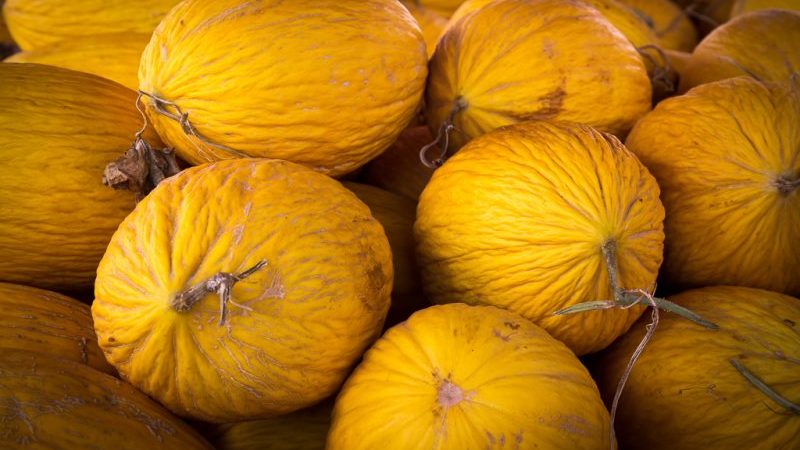
Melon Kassaba has a lot of advantages:
- high content of vitamin C, folic acid and complete absence of cholesterol;
- the opportunity to eat fruit for the New Year;
- excellent keeping quality and resistance to transportation;
- resistance to machine cleaning.
Among the disadvantages are:
- real melon flavor and juiciness are revealed only 2-3 months after harvest;
- in central Russia, cultivation is possible only through seedlings in a greenhouse.
Reviews
Reviews of the Kassaba melon are controversial. The taste and size of the fruit is highly dependent on the growing region.
Vladimir, Kiev: «I tried to grow the Lada melon (Kassaba summer variety). They grew up to 17 cm in diameter, no more. They took it off, lay there for a month - very tasty. "
Irina, Lipetsk region: “I set out to grow Kassaba melon. I liked that it is well kept. I have been planting early-ripening melon varieties for 4 years, but none are suitable for storage. I opted for the Honey Dew variety. Grew up seedlings, planted together with tomatoes in a greenhouse. I pinched the extra whips, left one fruit on each. Of all 8 ovaries, one has matured. We kept it in the cellar until December. I will say one thing: there is a lot of trouble with it, but it is inferior to the store's taste.
Vladislav, Voronezh region: “I am an experimental gardener. All the novelties of the garden-garden immediately appear at my dacha. Seeing the seeds of an unusual melon, I got interested and bought it. But we are not Uzbekistan, they grew up small and sour. I do not recommend it. "
Conclusion
Melon Kassaba is a delicious, nutrient-rich fruit.But for its cultivation, a number of conditions are required. A native of Asia Minor grows well on southern chernozems, but it is easier and more economical for residents of central Russia and northern latitudes to purchase winter melon in a large store.